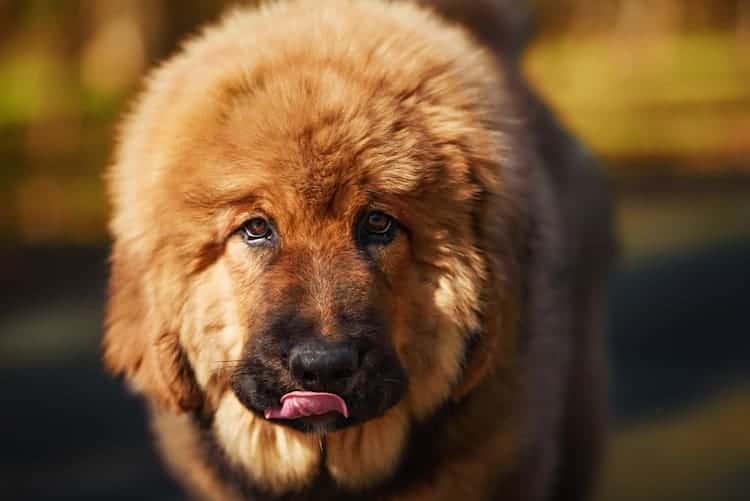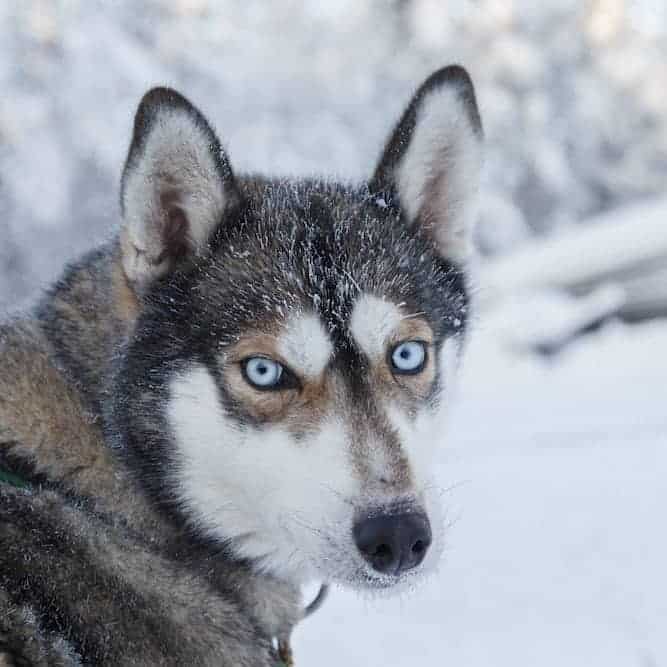Red Husky With Blue Eyes Tibetan Mastiff Dog
If you're thinking of finding a Tibetan Mastiff Siberian Husky mix, be prepared for a challenge. The two breeds share a lot of traits that combine to create a crossbreed that's stubborn, independent, and difficult to train.
Both the Siberian Husky and the Tibetan Mastiff make gentle family dogs, but even so, this mix is not for an inexperienced dog owner.
Read on to learn more.
The History and Personality of the Tibetan Mastiff
The Tibetan Mastiff's history is a little mysterious. Some dog historians believe he is not a true mastiff, that early Tibetans called all large dogs mastiffs.
Others think the Tibetan Mastiff was the original stock from which all mastiff breeds originated. We know that some Tibetan Mastiffs traveled with Tibetan nomads and guarded livestock. Others stayed put and guarded monasteries.
Either way, we know he was primarily bred to be a guard dog. Although he once traditionally guarded livestock, he is best suited to be a personal and property guardian.

The Tibetan Mastiff's most apparent trait is his size. This is a giant dog that can weigh up to 160 pounds with a height of 30 inches. His thick double coat makes him appear even larger.
Despite his size, he has a gentle and sensitive disposition to those he lives with, including children. To strangers, though, he can be aggressive because his guarding instinct is so strong.
This breed needs a lot of early socialization because of that guarding instinct. Otherwise, he can be aggressive toward anyone he sees as intruding into his territory.
He also has that challenging combination of intelligence and stubbornness that usually means a breed won't be easy to train.
To learn more about Tibetan Mastiff temperament and traits, see The Tibetan Mastiff: Meet This Imposing Giant's Temperament and So Much More.
The History and Personality of the Siberian Husky
Siberian Huskies are beautiful medium-sized dogs that are very wolf-like in appearance. They were bred by the Chukchi people of northeastern Siberia, in Russia, to pull sleds in a frigid environment.

Like the Tibetan Mastiff, the Siberian Husky has a gentle temperament. Huskies are natural pack dogs, meaning they enjoy being part of a family and are very good with children.
Unlike the Tibetan Mastiff, however, the Siberian Husky is outgoing and friendly. They don't make good watchdogs.
However, like the Tibetan Mastiff, the Siberian is both smart and independent-minded, which can make him a challenge to train.
In addition to that, the Husky is a high-energy dog. The breed appears to have developed an adaptation to change its metabolism. This allows them to run for miles while pulling a sled without burning through their fat stores.
What this means for a Husky owner is that this breed needs a lot of exercise.
Read more about the Siberian Husky temperament here.
The Tibetan Mastiff Siberian Husky Mix Temperament
When you cross two breeds, the puppies will inherit some traits from each parent. But the ratio can vary a lot, even among pups in the same litter.
There is no foolproof way to know what kind of temperament you're getting with a mixed breed. The best we can do is to study the traits of both breeds and consider all the variables, or things they don't have in common.
From there, you will need to evaluate the individual temperament of the dog you're considering.
For more information about crossbreed genetics, check out Top 15 Mastiff Mix Breeds.
So, to take a logical approach to assessing the likely Tibetan Mastiff Siberian Husky Mix temperament, let's start with what they have in common and how they differ.
Similarities
- Both breeds are intelligent, thinking dogs.
- They both have stubborn natures, which makes them challenging to train.
- Both like children (unless they are strangers, in the Tibetan's case).
- They are both loyal and gentle with family members.
- Neither can be trusted off-leash; they don't respond well to recall commands.
Variables
- The Tibetan is reserved and wary of strangers, while the Siberian is friendly to most people and other dogs.
- The Tibetan is territorial and can be aggressive.
- The Siberian has a strong prey drive; he may not be the right choice for a home with small pets.
- The Siberian has a higher energy level than the Tibetan. (Is it too obvious to say that Huskies love to run?)
- The Tibetan is a near-perfect guard dog, while the Siberian is too friendly for that job.
- The Mastiff has a serious demeanor and doesn't care to play, but Huskies are the exact opposite. They tend to be mischievous and outgoing.
Broadly speaking (keeping in mind that there's a high margin of error in generalities when it comes to mixed breeds), here are some of the temperament traits you may see in a mix of these two breeds:
Strong Will
Because both breeds are challenges to train with a stubborn streak, you may have your hands full teaching your dog that you're the boss. He would probably need a firm guiding hand with strict positive reinforcement training methods.
Need for Containment
Because both breeds are likely to run when off-leash, you will want to invest in a good fence.
Gentle Nature
But chances are excellent that you would have a good family dog, as both breeds are loyal and gentle with family members and are good with children.
Differences
The differences between the two breeds could play out in a host of different ways. There is absolutely no way to predict if the pup would be a friendlier Tibetan or a more reserved Siberian. Or exactly like one parent or the other, in that respect or any other trait.
It may do fine with other household pets, but it may delight in antagonizing them.
Worst case scenario? You could end up with a dog with the intense protectiveness, territorial nature, and tendency to aggression of the Tibetan combined with the high energy and prey drive of the Siberian. Oh, and add in the size of the Tibetan Mastiff.
Pair all of this with the intelligence and independence it would almost certainly inherit, and this might be a tough temperament to train, hence the double trouble.
And look out if your crossbreed has the cuddly nature of the Siberian but weighs over 100 pounds! If you're the type who likes your dog to sleep with you, you may need a bigger bed!
How Big are Tibetan Mastiff Siberian Husky Mix?
Height and Weight
As above, the Tibetan can weigh up to 160 pounds for a full-grown male. His height—at 30 inches—can exceed that of a human when he stands on two legs.
The Siberian, on the other hand, tops out at about 60 pounds.
Expect a mix of these two breeds to be much larger than the Siberian's 60 pounds and 24 inches. (Though of course gender will play a role in full-grown size).
What does a Tibetan Mastiff Siberian Husky Mix Look Like?
Again, this is impossible to predict exactly what a Tibetan Mastiff Siberian Husky Mix puppy will look like.
Above we gave you an idea of the size of this mix breed.
Here are possible colors of their coats.
Colors
Both breeds come in many colors.
Huskies can be:
- White with red,
- Silver,
- Gray or black,
- Solid white,
- Or "mostly black."
Their coats can have any of several marking patterns. There is even a woolly-coated Siberian, though this is rare and considered a fault.
Tibetans can be nearly any combination of:
- Blue,
- Red,
- Tan,
- Gray,
- Brown,
- And Gold.
Coat color genetics are complicated. But we think it's safe to say that when these two breeds are mixed, the possibilities are nearly unlimited.
Does the Tibetan Mastiff Siberian Husky Mix Shed?
Yes! Here comes that double trouble again. Both breeds have thick coats, and both "blow" their coats (the Tibetan Mastiff once a year and the Siberian Husky twice).
How Do You Groom a Tibetan Mastiff Siberian Husky Mix?
This mix's grooming needs are more predictable. Both parent breeds need weekly brushing during most of the year, but when they shed their undercoats once or twice a year, they need daily brushing.
Is the Tibetan Mastiff Siberian Husky Mix Hypoallergenic?
Neither breed is considered hypoallergenic, so a crossbreed would not be, either. But if you're looking for a hypoallergenic breed, we've compiled a list of them for you. Please see 30+ Best Hypoallergenic Dog Breeds for Allergy Sufferers.
How to Train a Tibetan Mastiff Siberian Husky Mix
Siberian Huskies are notoriously hard to train. They learn quickly enough, but they only cooperate when they want to.
On its web site, The Delaware Valley Siberian Husky Rescue advises that Siberians need consistent training, that "dogs don't understand 'sometimes.'" They do not do well with erratic rules. The same is true of the Tibetan Mastiff.
The rescue also points out that both breeds need strong leadership by their people because of their strong wills. You need to be the one in charge, or you will have difficulty controlling this mix.
The keys to training this crossbreed will be positive reinforcement, consistency, and firm expectations. This is a dog that will make you earn its respect.
This mixed-breed will also, more than likely, need a lot of early socialization. The Tibetan Mastiff is an intense guardian dog that is suspicious of strangers. He needs to learn early how to distinguish friend from foe, or he may become aggressive.
The Husky is friendlier, so that may temper the Tibetan's aggressive tendencies, but again, there's no way to predict this, so prepare for the worst and start socialization and training early.
Behaviors to Watch For
The Husky is an escape artist who likes to climb fences so he can run. The Tibetan Mastiff also loves to run. He is more agile than his size and build would lead you to believe. While the Husky is a marathon runner, the Tibetan Mastiff is more of a sprinter.
But neither likes to be called home.
The Husky is also a digger, and both breeds are chewers. Your dog could have any or all of these behavior issues.
Start training early and be consistent to get the best out of your Tibetan Mastiff Siberian Husky mix.
Staying Healthy
Both parent breeds are susceptible to hip dysplasia and eye conditions (entropion and ectropion for the Tibetan, cataracts, corneal dystrophy, and progressive retinal atrophy for the Siberian).
The Tibetan Mastiff is also prone to elbow dysplasia.
Helpful Dog Health Resource:
Note: Our Health is #1 Priority. It should be no different for your dog. But you need to help him. The Ultimate Guide to Dog Health is the answer. This handy guide will help you recognize the symptoms of the health problems above. Get the knowledge to stay ahead of these terrible issues that can rob your lovely dog from vigor and life. Help your friend make it to 14 yrs+ without pain and suffering.
Tibetan Mastiff Siberian Husky Mix Exercise Needs
Depending on how large your Tibetan Mastiff Siberian Husky mix is, you may need to limit its exercise while it's a puppy. Because of their size, Tibetan Mastiffs are prone to joint problems. Their exercise needs to be minimized until they're fully grown.
The Siberian, on the other hand, is a high-energy breed. Depending on the genes that it inherits, you could have a problem with a large, high-energy dog that can't get as much exercise as it needs. That first year until your dog reaches its adult growth may be a rough one.
You will want to be sure to offer your puppy plenty of companionship and attention. Because these are two smart breeds, your mix will need a lot of mental stimulation as well.
Dogs that don't get enough exercise or stimulation often become bored and destructive. You may find your Tibetan Mastiff Siberian Husky mix will chew, dig, or bark excessively. (Note that the Tibetan Mastiff is a barker, especially at night. This is an instinctive behavior from when the breed was often on guard duty during the night.)
What is the Tibetan Mastiff Siberian Husky Mix Lifespan?
Both the Tibetan Mastiff and the Husky breeds have a life expectancy of between 12 and 15 years.
Finding a Tibetan Mastiff Siberian Husky Mix for Rescue or Adoption
This crossbreed is not easy to find, mostly because the Tibetan Mastiff is relatively rare. You will probably not find a breeder who works with this mix, as it is not yet a popular "designer dog."
Your best bet would be to try local animal shelters, humane societies, or rescues. Most Tibetan Mastiff rescues and Husky rescues will take mixed-breeds, so they are probably the most likely place to find this mix.
Another option is to try Facebook groups and online sites such as adoptapet.com.
The Cost of a Tibetan Mastiff Siberian Husky Mix
At the time of this writing, we were not able to find a price for this mixed-breed online. Expect to pay a lot, though, if you're lucky enough to find one.
A purebred Tibetan Mastiff costs is anywhere from $1500 to $5000.
The price of a purebred Siberian Husky is less expensive, and ranges from $800 to $1500.
It's the Tibetan Mastiff's rarity that would determine the cost of a mix. But if you're able to find a rescue, the cost would be far lower than what you would pay from a breeder.
A Final Word on the Tibetan Mastiff Siberian Husky Mix
If you're still interested in a Tibetan Mastiff Siberian Husky mix, then you are obviously not faint of heart!
These two parent breeds are great dogs in their own ways, but each comes with training challenges.
One thing is for sure: This is one crossbreed that will keep you on your toes!

Calvin is the co-founder and one of the main contributors to dogtemperament.com. He has been an avid dog lover all his life. He enjoys researching and sharing great ideas on how you can avoid common pitfalls of dog ownership and build the most loving and enjoyable relationship with your dog.
Source: https://dogtemperament.com/tibetan-mastiff-siberian-husky-mix/
0 Response to "Red Husky With Blue Eyes Tibetan Mastiff Dog"
Post a Comment